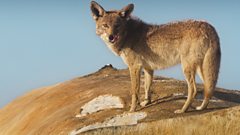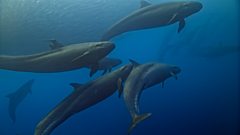From freshwater jungle ponds to the dark depths of the open ocean, air breathing mammals have found remarkable ways to overcome the many challenges of a life in water.
Water presents air-breathing mammals with some of the greatest challenges of any environment on Earth. Less than 2% of mammal species are considered truly marine mammals. Those that have evolved to live in water have become some of the most specialised of all. They are characterised by their intelligence and ingenuity, forming groups that cooperate and communicate, and that are able to take advantage of the incredible opportunities found at sea.
In this episode, we witness some of the most intimate and surprising behaviours of marine mammals. Raising the bar on our understanding of how whales and dolphins make their lives at sea, as well as meeting those terrestrial mammals that dip their toes, and sometimes more, into the watery world.
In a journey from inland freshwater pools, where monkeys take the plunge in search of a seasonal delight, to the mysterious deep open ocean, where the largest toothed predator on earth, the sperm whale, dives deep into the cold, dark depths, and far beyond that of nearly all other air-breathing animals. In a rare glimpse into this world, we follow it in its pursuit of prey, filmed in an astonishing moment by a specially designed on-board camera, able to withstand the crushing pressures experienced by the whale at these incredible depths.
Back at the surface, we witness incredible new behaviour: from the birth of a huge sperm whale calf, to orca hunting behaviour never before filmed, cementing their title as one of the greatest predators on earth. This sequence pits the na茂vet茅 and trust of a young humpback coming up against the brilliance of remarkable and calculating killers for the first time.
Off the coast of New Zealand, we see mammal species working together as a team, with false killer whales and bottlenose dolphins hunting in unison. But it鈥檚 not as simple as it may seem, as the false killer whales are in reality setting an elaborate trap, and in a surprisingly tender moment, they share their food with other false killers to ensure even those unable to make a catch can feed. Nearer shore we see a dolphin mother overcome the problems of hunting in the warm shallow waters of Florida Bay, creating rings of muddy water in order to catch fish and feed her family.
But only a few mammals like dolphins and whales have completely lost all their ties with land. Many, like Galapagos sea lions, have to return to the shore to give birth. Others, like the unique and bizarre star-nosed mole, with its highly sensitive nose and paddle-like feet, have successfully managed to straddle the world of land and water, hunting both underground and underwater. In Mexico, coastal coyotes have learnt they can benefit from the daily offerings washed up on the shore with each new tide, helping them to not just survive, but thrive, on the harsh fringes between the barren desert and fertile Pacific Ocean.
Last on
Clips
-
![]()
Humpback calf kidnap
Duration: 02:48
-
![]()
The star-nosed mole
Duration: 03:00
-
![]()
A coyote discovers a huge ocean bounty
Duration: 01:35
-
![]()
False killer whales and dolphins team up
Duration: 02:18
Credits
| Role | Contributor |
|---|---|
| Narrator | David Attenborough |
| Executive Producer | Roger Webb |
| Series Producer | Scott Alexander |
| Production Manager | Wendhy Sierra |
| Producer | Daniel Rasmussen |






